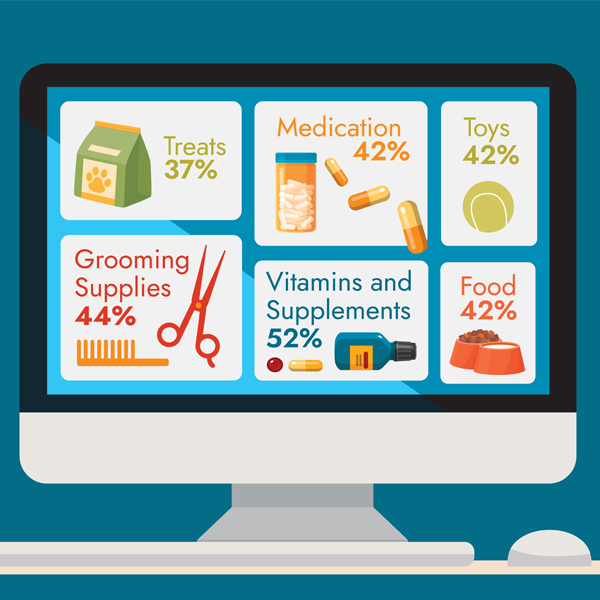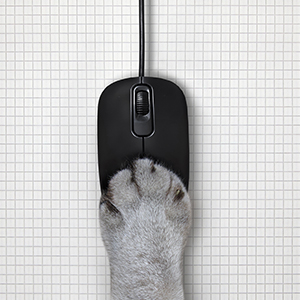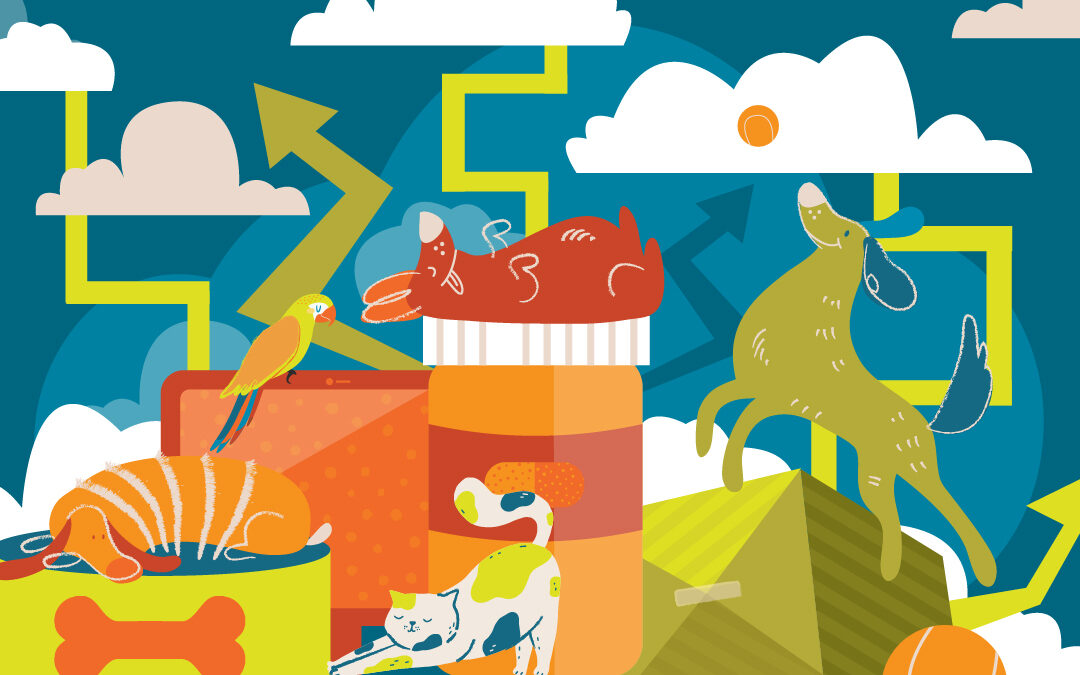The pet industry continues to expand and pet parents are spending more than ever, both in-store and online. Moreover, just like for themselves, pet owners are increasingly seeking a more personalized array of products to elevate the health of their pets. Let’s take a closer look at how brands can make the most of these industry trends and win in this burgeoning market.
1. Understanding and Connecting with Pet Parents
 Growth of the pet industry shows few signs of slowing down and continues to outpace that of other consumer markets in the USA. In 2021, sales of pet care* reached a whopping $123.6 billion, with pet food and treats accounting for over 40% of the pie.
Growth of the pet industry shows few signs of slowing down and continues to outpace that of other consumer markets in the USA. In 2021, sales of pet care* reached a whopping $123.6 billion, with pet food and treats accounting for over 40% of the pie.
Not only is spending rising, but so is pet ownership, with nearly 75% of all American households reporting currently have a pet of some type. Moreover, according to an AlphaWise survey report, pet ownership is expected to increase +14% by 2030, driven by expectation that 65% of 18-34-year-olds will acquire a pet in the next five years.
The sheer size and consistent growth of this industry affords great opportunity to brands competing in this space who get it right. However, as the category flourishes, so grows the competition. This means brands must do more than just offer good quality products. They must listen to and understand the needs, wants and values of the pet parents so that they can be at the cutting edge with products and brand messaging platforms that connect with these shoppers on both an emotional and functional level to forge loyalty. They must also consider engaging in targeted, scalable promotional and digital support programs to elevate brand awareness, household penetration and sales.
2. Making Online Sales Avenues Work Harder
Not only are pet parents spending more on Fido, but they are increasingly transitioning to ecommerce channels to find deals, convenience, and access to more pet-related brands and products. The recently released ‘US Pet Product Retail and Internet Shopping Trends’ report from Packaged Facts indicates that e-commerce accounted for roughly 36% of total industry sales and is expected to account for 45% of all pet product sales by 2026.
The pet food category is a perfect example of this. A Euromonitor International Report estimated 2022 food sales at brick-and-mortar stores to grow +3.7% in 2022 while it projected those on the e-commerce front to outpace in-store growth four-fold (+16.4%).
According to the APPA Pulse Study, growing percentages of pet owners are opting for ecommerce across a gamut of categories, including:

APPA Pulse Study: Pet Ownership in the Current Economy, July 2022
With increasingly more pet parents turning to DTC ecommerce to make purchases, brands selling on this channel must ensure the customer experience and service is flawless from the moment of entering the brand website through the time the order is delivered. To achieve this, DTC websites must make pet parents feel ‘at home,’ by:
- Showcasing high quality products that address (unmet) needs
- Reflecting emotionally relevant lifestyle imagery
- Sharing company values that align with today’s consumer (i.e., sustainability, cleaner ingredients)
- Emotionally engaging pet owners through contests and encouraging them to share their stories
- Offering seamless navigation
Merely building a beautiful ecommerce website and expecting they will come is not enough. Brands must also invest in email and strategic social media campaigns designed to drive traffic directly to the ecommerce site through relevant content and imagery that piques interest and give reason to ‘click’ to learn more.

For brands selling through third-party operated pet-related websites, such as Chewy and Petco, syndicated and retailer-driven promotional/media programs can assist with ‘breaking through the clutter,’ fueling sales and providing measurable results needed to inform future spending initiatives. Without question, the world of promoting pet products is very quickly becoming like that of CPG, with large pet retailers having grown highly sophisticated with their in-store/online sales building programs. Given that consumers are increasingly turning to online purchases is all the reason why brands should start exploring and integrating these scalable offerings into their strategies.
3. What’s Good for the Parent is Good for the Pet
 Today’s pet parents are doing more than just purchasing more pet products and doing so more actively online. They also seek products that will elevate quality of life/health for their four-legged family members. Simply put, they want for their pet children what they want for themselves: simple ingredients, clean labels, sustainability, and view purchasing products with these attributes as an extension of their love for their pets. Many are now seeking more complete-and-balanced food options to promote elevated wellness for their pets, as well as products and experiences designed to deliver specific functionality, including:
Today’s pet parents are doing more than just purchasing more pet products and doing so more actively online. They also seek products that will elevate quality of life/health for their four-legged family members. Simply put, they want for their pet children what they want for themselves: simple ingredients, clean labels, sustainability, and view purchasing products with these attributes as an extension of their love for their pets. Many are now seeking more complete-and-balanced food options to promote elevated wellness for their pets, as well as products and experiences designed to deliver specific functionality, including:
- Pet foods with specific functional attributes (i.e., weight control, healthy skin & coat, digestive care, etc.)
- Pet supplements for health and wellness
- CBD supplements
- Other premium CBD products for dogs and cats
- Personalized online DTC experiences
- Pet searches on internet search engines
Insights suggest these product segments will continue to grow rapidly provided consumers find value and benefit in them for their pets. This means brands offering health/wellness centric products should actively take the pulse of their consumers to determine what is important to them and how their needs can be better met. This can be accomplished by simply emailing customers from existing ecommerce databases and engaging them in short surveys (with a sweepstakes overlay to encourage participation) to conducting more formal research approaches such as focus groups.
4. Leading with Sustainability
Just like they want healthier food and treat choices for themselves and their pets, today’s pet parents are also showing increasing support for environmentally friendly products. As a result, many pet-related brands are adopting sustainability as a core strategic pillar, with new consumer insights elevating directives for manufacturers to consider embracing regenerative farming practices, cleaner labels/reduced food processing and recyclable packaging alternatives. For new brand startups that have positioned themselves around consumer sentiments on environmental changes and carbon footprint, these new directives have proven to be real game changers.
5. Rising to the Challenge
On a macro level, the pet industry is having to do a fast-paced dance – meet manufacturing challenges of supply chain shortages, logistics, and ingredient costs, all while addressing changing consumer needs/wants for superior nutrition, environmental/sustainable driven products.
As long as consumers call for change, brands will step up to the plate to meet the challenges and demands being made, with those at the table owning a consumer-driven platform and employing the right mix of promotional and brand-building strategies being best poised to win the game. With great growth opportunities at stake, brand players will no doubt deliver.
Looking to engage more pet parents and drive more sales for your brand? Our team of marketing experts is ready to place all paws on deck!
We have the experience, insight and scalable solutions to ensure your brand is getting the attention it deserves with consumers and the trade. So whether you’re seeking strategic branding support, need to add some zest into your online channel or are looking to place more spark into your promotional programs. We invite you to learn more about how we think, who we are and what we do as a full-service agency. Let’s connect and explore what’s possible for your brand!
* includes pet food/treats, vet care and related products, supplies, live animals and OTC medications
Sources: American Pet Products Association (APPA), AlphaWise Survey, Euromonitor International, NielsenIQ, Pet Food Processing, Package Facts



